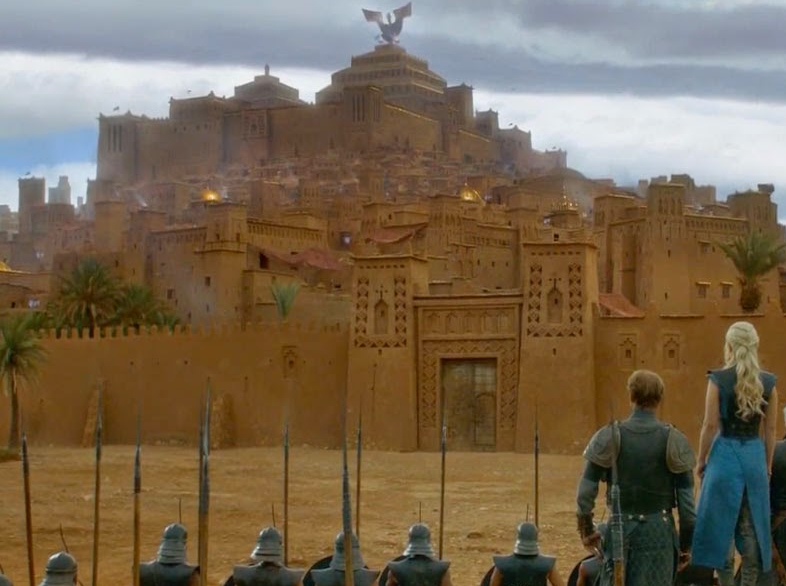No longer just a computer-generated mock-up on a series of handsome models, here it is on a more real but let’s be honest, less handsome person. I hope it gets Zazzle lots of sales…


The Personal Blog of Zach Heise
No longer just a computer-generated mock-up on a series of handsome models, here it is on a more real but let’s be honest, less handsome person. I hope it gets Zazzle lots of sales…


Nerdy post here – sorry, no fun trip pictures this time.
The ability of the Linux webserver to simply look at a folder filled with files and then generate an index of them is one of its earliest and most elegant features. You are probably well used to seeing folders like this around the internet – that’s an example.
However, since around 2009 or so, I had been using a modified version of that made by a developer named Justin Hagstrom – you can see just how old his original “AutoIndex” PHP based system is because his site hasn’t changed much!
Last week I got an email from Google Domains alerting me that one of the Google Earth kmz/kml map files from biking and hiking trips that I host at https://heiseheise.com/files was unable to be indexed anymore – HTTP error 500, not found.
I don’t generally visit my own file server; why would I, I have the files on my computers already! But sure enough – the site was dead, not loading anything. My log files showed that it died somewhere in October 2023, which was about when I did a mandated PHP update on the webserver. Mandated in the sense that Ionos, my hosting company, told me that I’d be billed an extra $5 each month if I didn’t upgrade from PHP 7.4 to PHP 8.2, the current mainline support version.
This is to be expected I suppose – in a vacuum, we could keep using old versions of all software forever, but thanks to the Internet not being a vacuum, we’re in a neverending cycle of needing to upgrade to prevent security vulnerabilities (and add new features too I guess; but who needs those? Sure, we could glue generative AI garbage onto a terminal program – that’ll be popular, right? /sarcasm Seriously, security is necessary, unfortunately… new features are…. eh? I don’t really care).
Ah-hah, I thought – well, surely the PHP upgrade killed the /files system. Considering that as you can see from Justin’s link above, it was un-updated since 2007, I wasn’t entirely surprised. But now we have places like Github, so I immediately went on a mission to see if anyone had forked his old code. And they had! This one looked like the most full featured, so I simply dumped it in the /files subdirectory on my webserver and expected everything to be great. But it wasn’t. More 500 errors. What the heck?
I replicated it on my work server – same thing. I spoke with our Linux admin and he immediately pointed me towards this closed issue (which I commented on today) saying that, ah-hah, it doesn’t work with PHP 8 either, which is what both our work server and my personal server are on.
Sure enough, when I went to the rubo77 fork of AutoIndex PHP, and overwrote the BeitDina fork with its data – now everything works fine. I did have to clear out a bunch of random stuff that BeitDina emptied onto my webserver, as it seems like the developer has a bunch of new functionality planned for the site. Unfortunately, supporting PHP 8 is the #1 feature I needed right now, not new visual whizbangs!
Now /files is back up and running again, with a slightly new look, the ability to download the entire site as a .tar.gz compressed file, and calculate hashes in MD5 to confirm that data wasn’t modified or damaged during a download (useful for the .ISO files I host there perhaps). Hopefully this new version will last me another 15 years!
That’s the email client, not the Ford car (While I do like the car, I leave the love up to my Uncle Jim, who bought and restored a 1957 Thunderbird decades ago – he often takes it to car shows).
No, for me, it’s the email client which first came out in 2003, from the Mozilla Foundation. I switched to it around 2005 from Microsoft’s basic email program Outlook Express (now discontinued), which came bundled with Windows XP, and never looked back. The sheer scope of customization with Thunderbird wowed me immediately; I love being able to alter the entire user interface to suit my whims, and its support for all manner of email address type is second to none. At work I use it with my work email address (Office 365 using the Activesync protocol, provided by an add-on extension), Gmail, AOL Mail, and Hotmail (all using the elderly IMAP protocol). I used to have theme modifications in place to add little lines between every email so that my eye would better track each message’s columns of From, Date, and Size. I even had an extension that would tell me what email clients other people were sending me email from.
Mozilla Thunderbird for email, and Mozilla Firefox for browsing, have been a great combo for decades. While I generally think that people advertising for private, for-profit companies is silly (what, you’re going to pay THEM money, to wear THEIR logo on your body? Companies should be paying you to advertise for them, not the other way around), I definitely feel differently about open-source free-software foundations like Mozilla. They put their money into developing great software and releasing it at zero cost to the customer.
Many years ago, Mozilla had a Community Store. They still have the old blog post up that touts it, but all the links in it are dead now and just redirect back to the homepage. The only thing it sold, however, was Firefox merchandise – nothing about Thunderbird. While I bought (and still wear constantly) a Firefox tee right away, I’ve messaged Thunderbird’s community moderators several times over the past 15 years asking them – why not put up a Thunderbird shirt for sale at “fundraiser” prices – $30, $40, and then people like me would pay a premium for the shirt, and the Foundation could pocket the rest? While they agreed, and sent me stickers and pins to thank me for being a fan – no shirt ever went on sale, and now you can’t even get any (official, mind you) Mozilla merch, not even Firefox.
So if they weren’t going to sell me a shirt to wear my love of Thunderbird in public, I’d make one myself.
We live in a custom-order world though now. Back in 2010 I made Pro-Palestine t-shirt via Cafepress, who I (believe?) was one of the early players in the custom made-to-order-product category. As most people can guess, a lot has changed in the e-commerce world since then, and now you’ll trip over dozens of websites to make custom products, be it for your personal use, or to sell and make a (tiny) profit (as of course, you’re only getting paid for your design and the company is doing all the actual work – and like as not, some other person on the internet will see your design and rip it off and sell it themselves pretty rapidly).
Mozilla recently changed the logo of Thunderbird to be…how shall I put this tactfully… “simplified.” This is part of a larger trend, and I’m not a big fan of it. Thankfully, I was able to find a scalable vector graphic (SVG) version of their classic logo, and armed with that, I was easily able to import the 400KB .svg file into GIMP, set the resolution as 3000×3000 and the DPI to 300, and export a whopping 25MB rasterized bitmap PNG file out. I love vector graphics, particularly for logos, and the fact that you can export any size bitmap file you want makes them perfect for archiving. What might be “high resolution enough” for using on a product today, might not be in 15 years, but that vector image can always be used to generate a higher-resolution file in the future.
I went with zazzle.com and uploaded the PNG file (most of these custom-order sites don’t want the SVG files, they want rasterized images) and added some text. I am not sure about Mozilla’s legal team’s opinion on fan products like this (I’m sure they do have lawyers, despite being a friendly open-source company) so I made sure to not use their company name at all. I did fret a little bit about the fact that Zazzle only does “Direct to Garment” printing rather than the more durable classic Screen Printing, but since this is just a one-off shirt and I’m not making hundreds of them, I guess I’ll have to take what I can get. My Pro-Palestine shirt, also DTG, has held up pretty well in the wash for the past 14 years; I always line-dry it rather than tumble, and I think that helps. Here’s the result that I hope will show up in a couple weeks.
Email is great. I love it, vastly more than text messages for sure, certainly more than proprietary, dumbed-down chat clients like Google Chat, Facebook Messenger, Apple iMessage, and even Telegram, which is probably my second way to communicate after email. Email is interoperable, extensible, and easy to organize, and if you have a good junk mail filter, it doesn’t even show its downsides very much (that is, that so much garbage email gets blasted around the planet every second). New upgrades to email like SPF and DKIM records in the past decade are even making long-time issues like message spoofing less of a problem.
I’ve had people throughout the world comment appreciably on my Firefox shirt for years now, particularly while visiting China (probably due to the lack of Google Chrome availability), and I hope to make a few more people curious about what this “Thunderbird” thing is, and maybe check it out. You never know when <insert email provider name here> might decide to close your account for any reason and without explanation, and then you’ll really wish you had an archive of all of your email safe on your computer. Thunderbird is there for you.
The final phase of our vacation in Morocco had begun. With Nicole and Connie safely on their way back to the USA, our travel group was back down to the family group, same as it had begun a week and a half ago. Our next destination was the incredibly famous, highly photographed “blue city” of Chefchaouen. Mom mentioned that she was pretty sure it was on the cover of all of the ‘visit Morocco’ guidebooks she owned, and pictures of the city may have even played a part in creating her initial wish to visit the country over a decade ago. So, good work Chefchaouen; you’re a beacon to tourism for the nation.
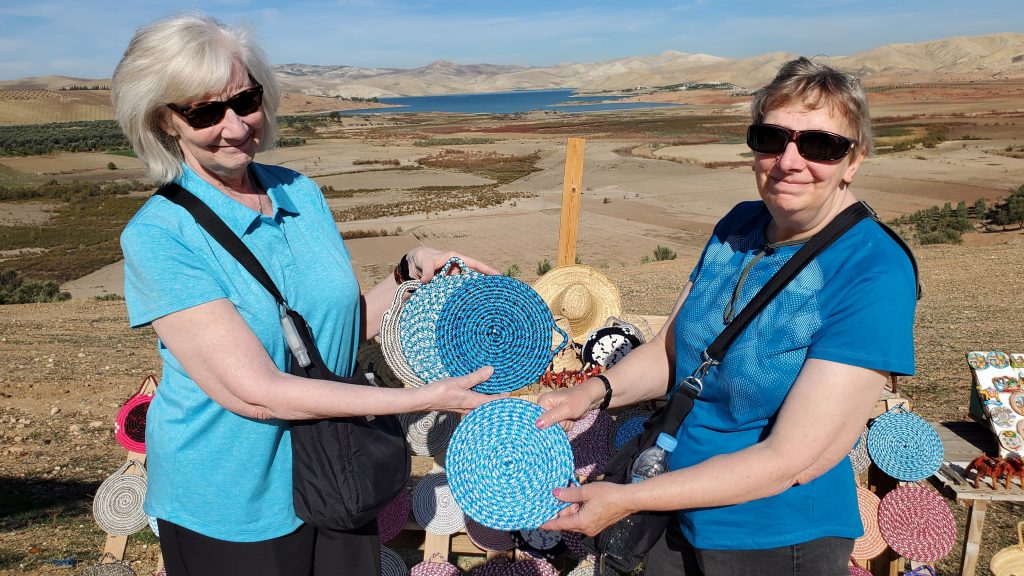
Part of the journey involved stopping by the ancient Roman city of Volubilis for a couple hours, one of the best-preserved examples of Roman influence on the south side of the Mediterranean. Omar said that Odynovo Tours had subcontracted this part of the trip to a local guide, Amarad, who lived in the nearby village of Fertassa. Amarad’s command of English wasn’t great, but he was enthusiastic in his descriptions of the various surviving Mosaics that had been unearthed over the past couple centuries before the site reached UNESCO status. Almost no trees were allowed to sprout up in the extremely low ruins so the November sun beat heavily upon us. Apparently a lot of the Roman stones had been repurposed by various rulers over the centuries to build the city of Meknes a couple dozen kilometers to the south, explaining why the surviving city ruins were “knee high.”
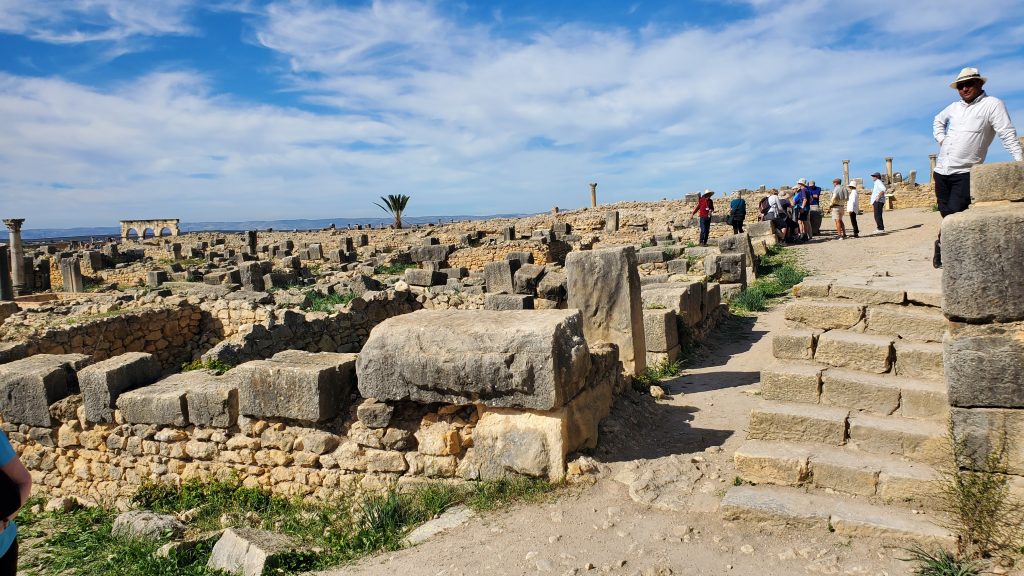
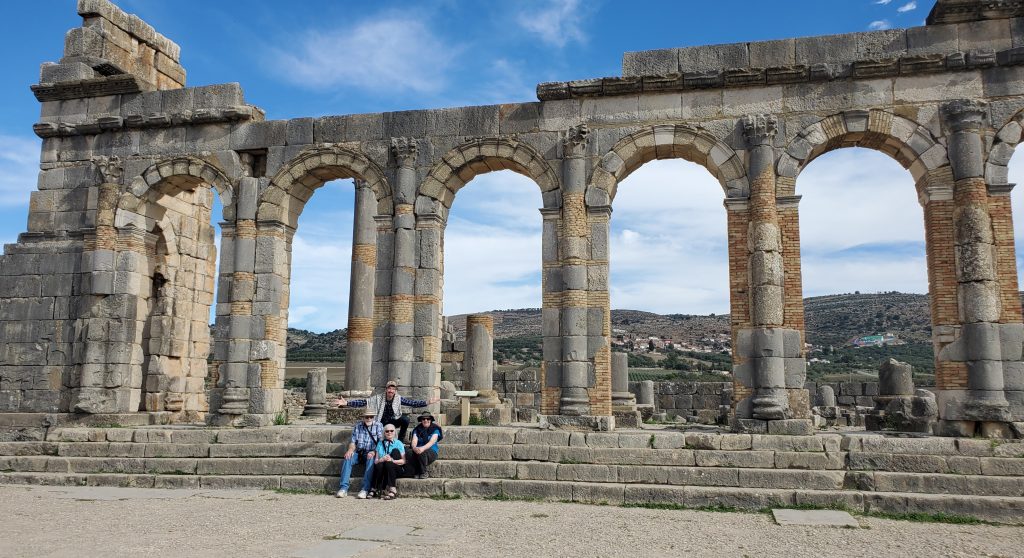
We reached Chefchaouen in the early evening as the sun was starting to set. Nestled into the hills between two mountain slopes, we examined it from one of said slopes alongside a small tour bus of about 20 Asian tourists. From up here, it didn’t actually look that blue and I wondered where the heck the pictures came from; I was expecting to crest the hillside and look down onto a town that might as well be as blue as the sea. Omar explained that it was further in (here he gestured to a section of town in the northeast corner of the city) that they painted everything blue, and it was difficult to see from here.
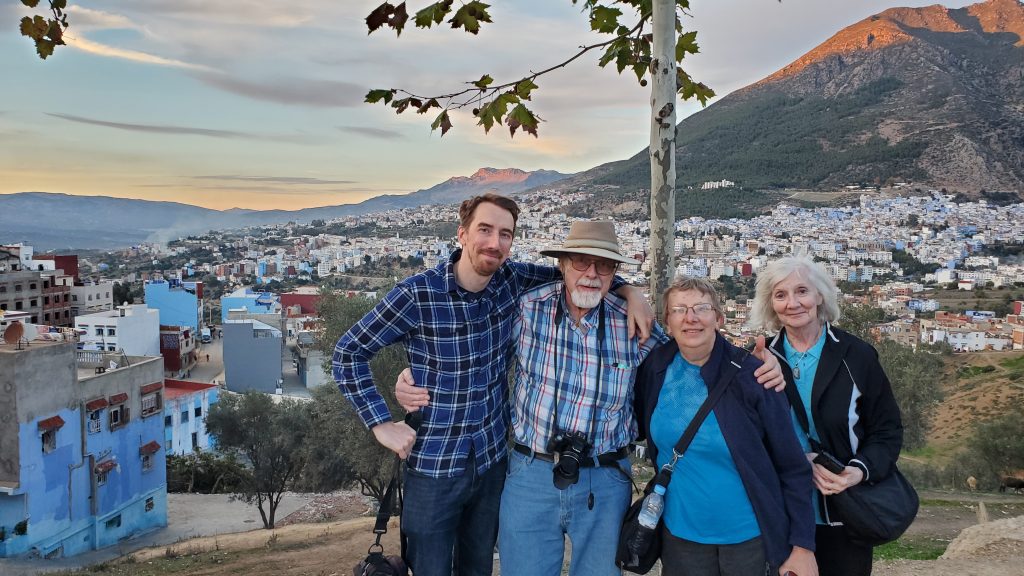
It turned out that our big Mercedes touring minibus (large van?) was not allowed to go into the old city where our hotel was, so Omar flagged down a couple of taxis to take us and our luggage up the narrow streets to “Vanci Hotel” where we’d be spending our single night in the city. In comparison to the Palais Faraj or Ksar Ighnda, it was a bit of a step down, but Odynovo had warned us that here in the high-tourism season of November, hotels in Chefchaouen booked up incredibly fast and this rather middling hotel was really the only place left that could accommodate the four of us in 3 separate rooms. As we were checking in, a group of 30 Asian tourists flooded into the lobby, led by a Moroccan guide. I can’t find any news articles about this but it was quite interesting actually; of course we had seen other tour groups on our trip so far, but here in Chefchaouen the vast majority of large groups were Asian. I mentioned this to Omar, and he said that he thought it was because traveling outside China had been somewhat difficult before 1978, ever since that point, Chinese tourism had been constantly rising, filled with tourists that were obsessed with taking as many pictures and seeing as much as they possibly could. When put in that perspective, I can completely sympathize that they finally were free to travel and therefore, wanted to make the most of it. Maybe there was also a worry that perhaps the Chinese Communist Party will take their freedom away again at their whim someday too?
Omar met us the next morning at the hotel at 8am to begin our walking tour. Several friendly local dogs who found us in the first 10 minutes of the walk seemed to enjoy our companionship, playing with a discarded shoe they had found (way to be stereotypes, dogs!) and romping within 20 feet of us for the first half an hour. It was still quiet at this time of morning except for gradually increasing sound of water. We came to the source eventually – a fast moving narrow channel of water that seemed to be used for washing by numerous stern looking elderly ladies. Omar cautioned us not to photograph them (I hope the Asian tourists got a similar memo), and we crossed a bridge over the stream and into the picturesque part of town. Here’s where the souvenir stands began and all* the walls were painted blue.
Why the asterisk you ask? Well, it seemed like in most cases, despite most of the buildings being 2, 3 or even 4 stories tall, in these narrow car-less alleys we were walking through, the blue color only extended up to the top of the ground floor – the upper areas were left the drab color of unpainted concrete. It definitely helped to explain why the previous day, when viewed from a distance, the city didn’t actually look that blue.
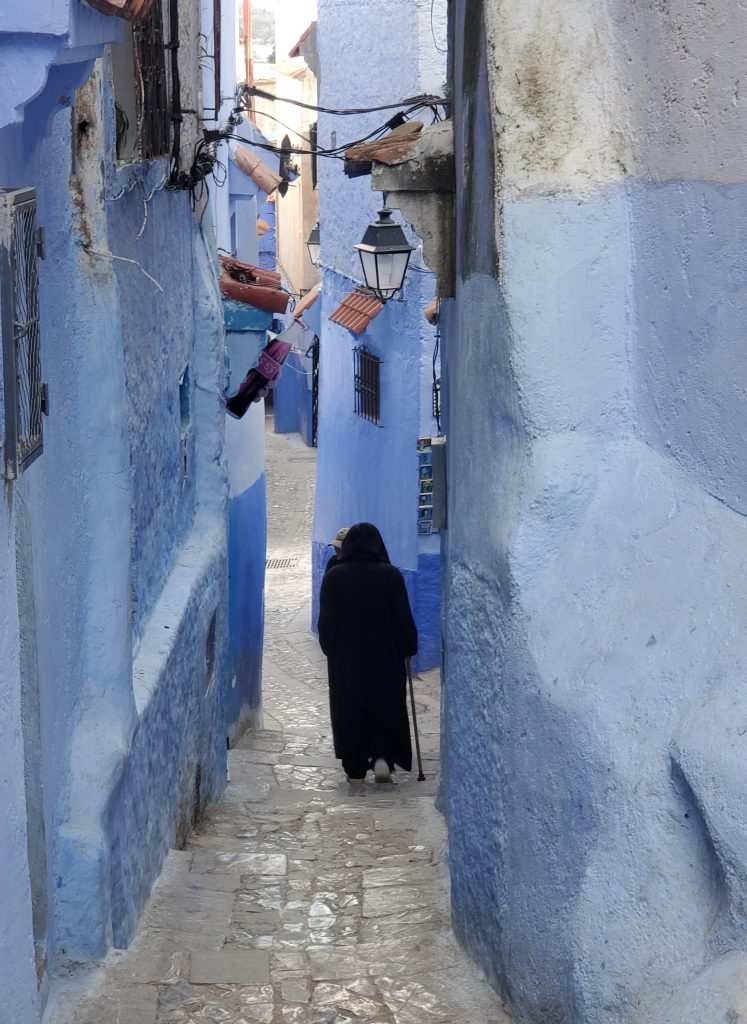
It was pretty, of course, but felt extremely touristy. In one town square, we came across a group of tourist women in lawn chairs who were simply painting a blue wall and alley. I was getting a rather bizarre vibe from the city by this point – what am I missing??? It’s a city with a lot of blue paint! Is this the best idea to make into tourism or what? I mean, I get that it has a historical background, having been inhabited by a lot of Jewish folks who were forced to flee Europe during the Re-conquest and the expulsion of all non-Christians from Andalusia.
Continue reading this post…The mosaic-coated pillars of our hotel stretched away into the darkness of the night sky as Yaseen unloaded our bags. A trio of brown-suited bellhops, and a duo of black-suited concierges, greeted us at the 10 foot tall gate to usher us into the reception area. Credit cards were solemnly run for ‘incidentals’ and presented back to us with bowed heads and a clearly trained 2-handed, thumb and forefinger grip. This was the Palais Faraj, built in 1911 by a local judge favored by the Sultan as a home for his immediate and extended family – one year before the curtain came down on the Sultanate and the French forced the nation into a Protectorate status. So while it was only a century old, only after I later chatted with the concierge did I learn this, because the judge had a decidedly 1600’s taste in decor, following the yellow/blue/black/green mosaic style we’d seen in many of the madrasas of that time period.
We were led through numerous sitting rooms, libraries, stepping up and down cautiously in the dim light to avoid tripping over the many small changes in floor height in our path. Some areas had once been courtyards, but all these courtyards had since been covered in glass caps; Fes after all does get plenty of rain, and tourism at a hotel like this demands that guests never sully their dainty heads with wet.
Since our drive the previous day had been so long, Omar let us sleep in a bit, picking us up after our continental breakfast on the top of the building. Our view looked out over the edge of the Old City, across the Ouislane Valley, and upon the other side framed in the morning mists was a blocky, imposing beige structure called the South Tower. We’d be seeing that later.
For now, though, we’d be starting in the Old City. Omar would be our guide, and he led us down the narrowest alleys and corridors we’d seen yet, sometimes no more than half a meter wide. In some places the 400 year old buildings were practically leaning into each other over the alleys, and needed to be braced with new-looking wooden supports. Omar explained that alleys this small would never have been okay with the municipality of the time, but instead were once a single large house, but then the owner had sold it, and it had been divided into smaller and smaller parcels until only these little practical crawlspaces remained.
We saw a museum called Nejjarine, a beautiful former inn that now housed three stories worth of “stuff Moroccans have made that is made of wood.” If you can make it out of wood, there was probably some creation of that family in that museum. Musical instruments! Doors! Bridal palanquins! Mosque screens! Weapons! Islamic legal decisions! Toys! Intricately cut and painted shelves! It was quite fancy and all the signs were written in Arabic, English, and French so dad and I could browse inscriptions to our hearts’ content.
Next was another madrasa, similar to Ben Yousef that we had seen back in Marrakech. This was al-Attarine, and it was similarly beautiful with its mosaics, fresco inscriptions, and carved wood upper areas. One immediate difference I noticed between Ben Yousef and Attarine was in the student dormitory area – while the former’s rooms were darken, with windows only looking back into the hallways, these ones were well lit, with openings in the ceilings to let sunlight pour in (like the Palais Faraj, they had been capped with glass for tourism purposes), and almost, if not all, student rooms had an outside facing window. Omar said that unlike Ben Yousef, which was more of a ‘graduate school’ for students practiced enough to have already memorized the Qur’an, Attarine was made for younger children who could graduate through ‘levels’ of memorizing parts of the Qur’an before the whole thing, and also that there was more competition from other possible madrasas that wanted students, so they wanted to make the student lodgings more attractive.
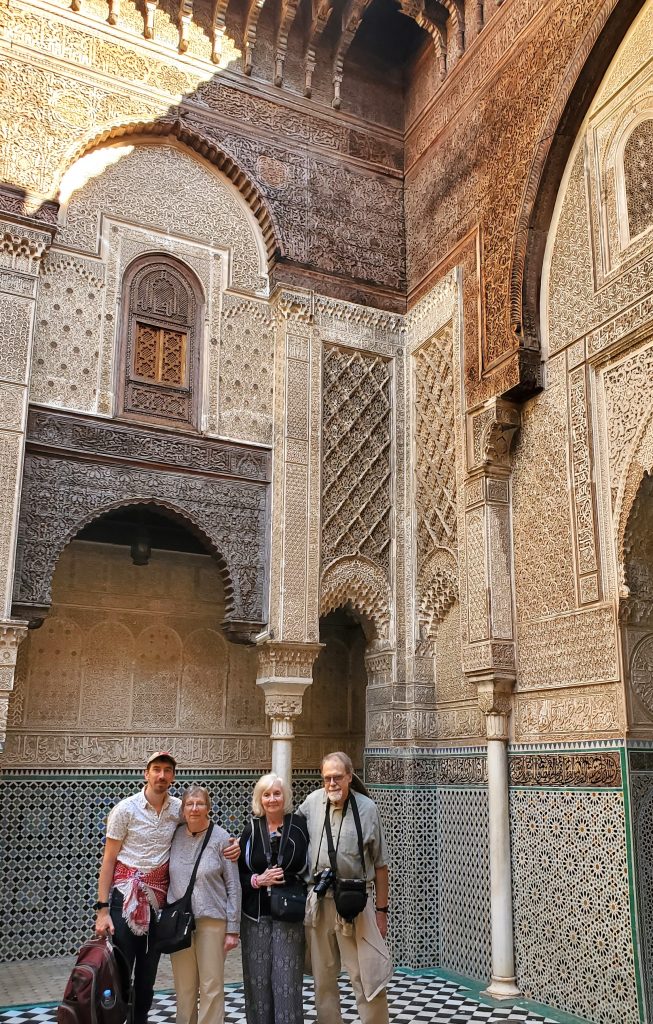
We made a couple of stops in handicraft areas; the famous tanneries which are hundreds of years old and a well-known tourist stop. Dozens of pits in a 2000 square meter courtyard emitting a smell that could be described as ‘interesting’ in the politest sense. The entrance was nondescript, a staircase through a tiny door with merely a sign that said “tanneries; looking is free!” A fellow sat on the first landing with a sack of fresh mint leaves next to him, and he smiled as he handed a sprig to each tourist, and gestured to hold them under our noses. Every wall and every passage was covered in leather goods of all types and colors; jackets, belts, and thousands of handbags. Effective insulators, we could barely hear the murmur of the hundred other tourists ahead of us as we climbed and walked through the tangled hallways to find the ‘overlook’ of the tannery pits. The men below had their trousers hitched up to their thighs and were working the leather with their feet. The employee describing the hectic work below mentioned that pigeon dung was used as part of the process too, but the smell at this point was harsh, thick, acrid, and not really describable beyond ‘it smelled like a tannery.’
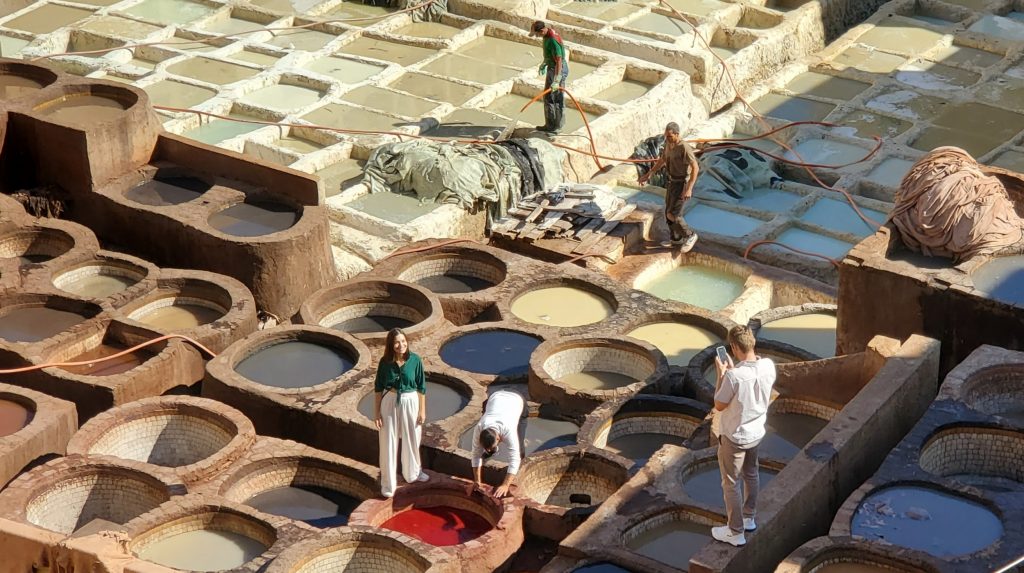
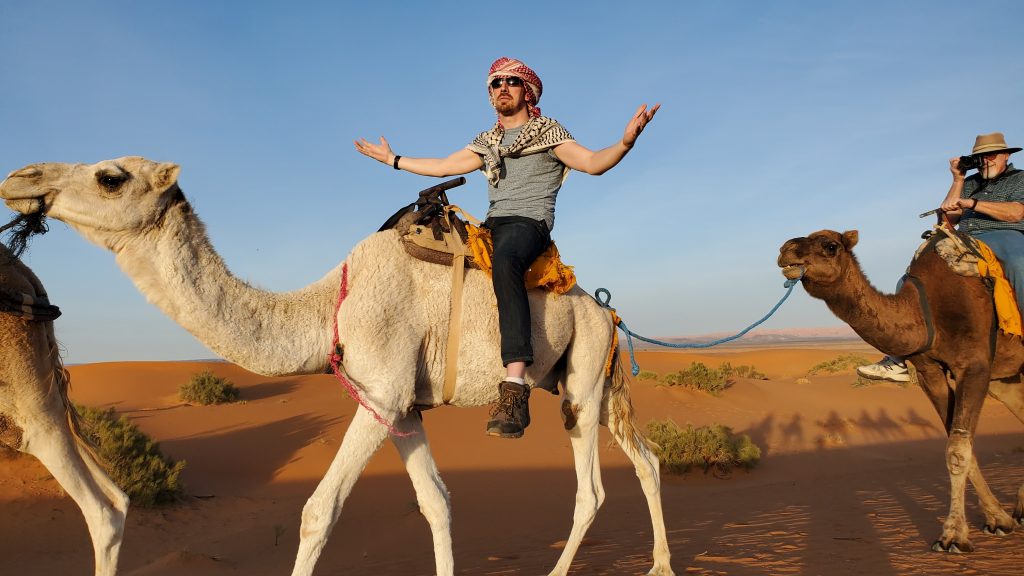
Our traveling home away-from-home/hotel for the next 10 days is a black, 12 seat Mercedes van. It rumbled contentedly up the High Atlas mountains, heading east, always east (and usually south) from Marrakech. We had been met at our hotel by Omar, with a close-trimmed black beard and mustache, baseball cap, and well-lined smiling face. A 48 year old freelancer hired by Odynovo, he was partnered with Yaseen the driver, a few years younger than me and also wearing braces, same as I’ve had for the past six months. Yaseen came with the van from a separate company too, but Omar told me that the two of them had worked together dozens of times over the past few years with small private tours. As his regular tour size was 45 people in a full-sized bus, hopefully we represent a less stressful and more relaxing tour for him, too.
The road we were on heading into the mountain switchbacks were well-maintained and recently paved, and as we paused to take pictures on a mountain vista overlooking the kilometers we had just traveled, I commented to Omar about the strange way the trees seemed to grow extensively on one part of a mountainside to our west, but then stop abruptly in almost a straight line. Omar, like our previous two guides before us, was quick to extol the wisdom of both the current king and the past one – a tree-planting initiative had been created by the monarchy and government in the past several decades almost exclusively using a special type of oak native to the Mediterranean region (I’d never heard of it; the waxy, water-retaining leaves look almost like holly, don’t they?) that would, in time, develop a deep root system, preventing erosion and rock-slides as well as improving the soil quality itself. While not yet everywhere, Omar thought large stands of these trees would eventually cover every public mountainside in the country.
We had a brief stop at a rug shop, a multi-village cooperative, on the other side of the mountain range. The small, salt-and-pepper bearded Berber sheikh introduced himself to our group as “Ali Baba” and like most of the others we’d met so far, launched into his explanation nee sales spiel with the practiced ease of a longtime businessman. At my request, he pointed to his wall-hung Certificate of Official Cooperative-ness from the government, and said that this shop he ran was owned by a dozen people together, and coordinated the distribution of wool from the widespread (about 50km worth of villages/families) shepherds to the weavers themselves, who mostly work at home, determined what patterns and designs to make this month, etc. There were 2 women working in Ali Baba’s shop while we visited, and he explained that the women would take turns coming in to demonstrate the process to tourists for a few weeks at a time. They smiled shyly at us as they rested from clacking at their vertical hand-looms, and one got up to serve us the ever-present mint tea. I asked them if working for a cooperative was a good job and they glanced at each other, nodded, and giggled. Their Arabic was limited, as they primarily spoke Berber, but Ali Baba helped translate from my English/bad Arabic to them.
The sizes of the carpets ranged from about a half meter square (“if you are looking for a post card?” Ali Baba laughed as he pointed them out) to the largest he and another male assistant spread before us, about 4×6 meters and intricately designed with lots of tight, close stitches and many colors. Ali Baba said that of course, the carpets made by less-experienced workers would have less-tight/close together threads and one could see more of the plain white “loom lines” (I’m sure there’s a proper word for it but I’m not a weaver) if you nudged the cloth hard with your finger, instead of the colored thread. He pointed to the huge carpet commanding the attention of the room. “This… golden fingered women!” he laughed, and gestured to a smaller piece that was off to the side, pulling at the threads. “This is copper fingers! Just starting out, but if she has patience and practice, she will get there.” Apparently all the weaving itself is done by women (“you know, ladies – men have no patience, right?”) but the shepherding and related farm work is done by the men. Unlike the women’s pharmacy cooperative in Marrakech, this was a holistic cooperative with work distributed between the two sexes.
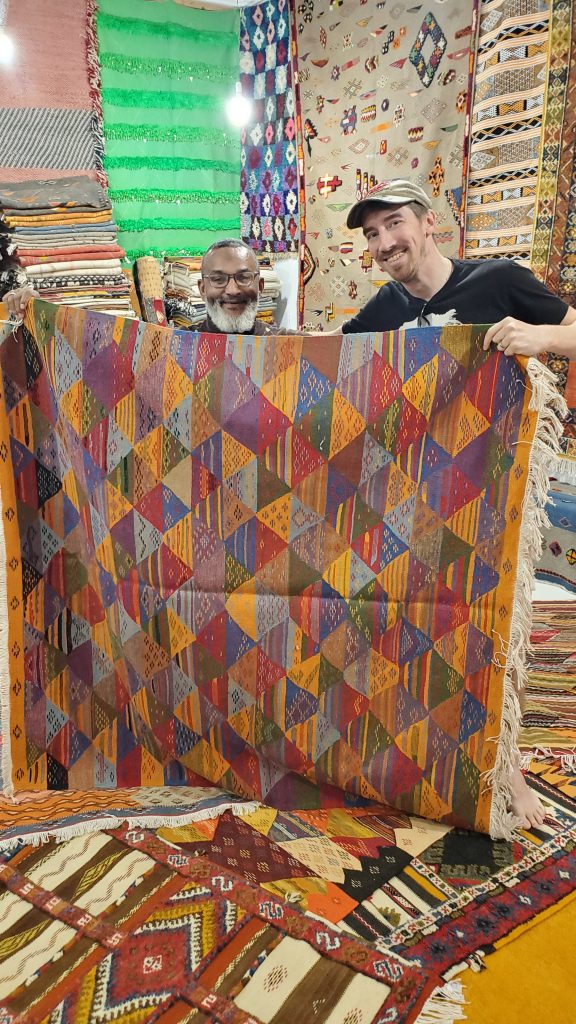
Lunch was at a heavily trafficked tourist restaurant in the village Ait Ben Haddou. Ait is a Berber word for tribe, so the full name is “The tribe of the sons of Haddou.” There were at least 3 busloads of people swarming about the numerous tables, and equally numerous, harried looking staff – lunch options were a prix fixe sets of soup/salad + pizza/tagine/couscous + fruit for dessert. Omar and Yaseen (we would learn now, and continue to see over the next few days) would generally not eat with us, disappearing elsewhere during meals and Omar would reappear magically just as we were ready to stand up. Therefore although we could see a tall hill to the northeast with a small structure atop it, and people walking all over said hill, we had no idea what it was. We knew there was supposed to be a centuries-old village, created from carefully daubed and packed mud and cane that was what we were visiting, but it wasn’t visible from this side.
After lunch, our three companions decided to head straight to the hotel, so my parents and I had a nice hour-long walk with Omar as he went into Tour Guide mode for us. We walked along meandering gravel paths from the restaurant toward the aforementioned hill, circling round it and there, Ait Ben Haddou came into view. It was indeed a unique sight. While we had been seeing milk-chocolate brown thick-walled buildings for several hours in this region, this was the largest collection of them yet, looking like they were built on top of each other with the optical illusion of the steep hill behind them. Many of the largest buildings also had simple but elegant pressed Berber symbols and motifs in repeating shapes around their crenelated tops. Omar told us that about a thousand people still lived in this ancient village, and another several hundred lived in the “new city” across the road from it. Unsurprisingly, luxury hotels for tourists were springing up all over this area and jobs were being created for the local Berber villagers (mostly) in them.
We learned that Ait ben Haddou and the nearest large city to it, Ouarzazate, were also internationally known due to their connection to the film industry, both of the USA’s but also France and others. From a cynical perspective, the local Berbers were inexpensive extras for multibillion dollar movie machines, yes. But on the positive side, they and their parents and even grandparents had been doing it for so long, they were also now in high demand for other reasons. Intelligent, patient, and extremely practiced, the Berber would also offer up their livestock and other animals to be extras as well, continuing to lend authenticity to background shots. The appearance of this region is similar to many areas of the American southwest, and to the average moviegoer, also any other part of the Arab world – or fantasy worlds. Some famous examples that had at least one scene here were Gladiator, Lawrence of Arabia, and the more recent Game of Thrones scenes that involved the city of Yunkai, one of the cities in Essos (not the main region Westeros) that is filled with enslaved people. Many of these enslaved characters were of course, played by the local folks of Ait ben Haddou. In Ourazazate there are sound stages and lots for recording that doesn’t need to be onsite, too.
